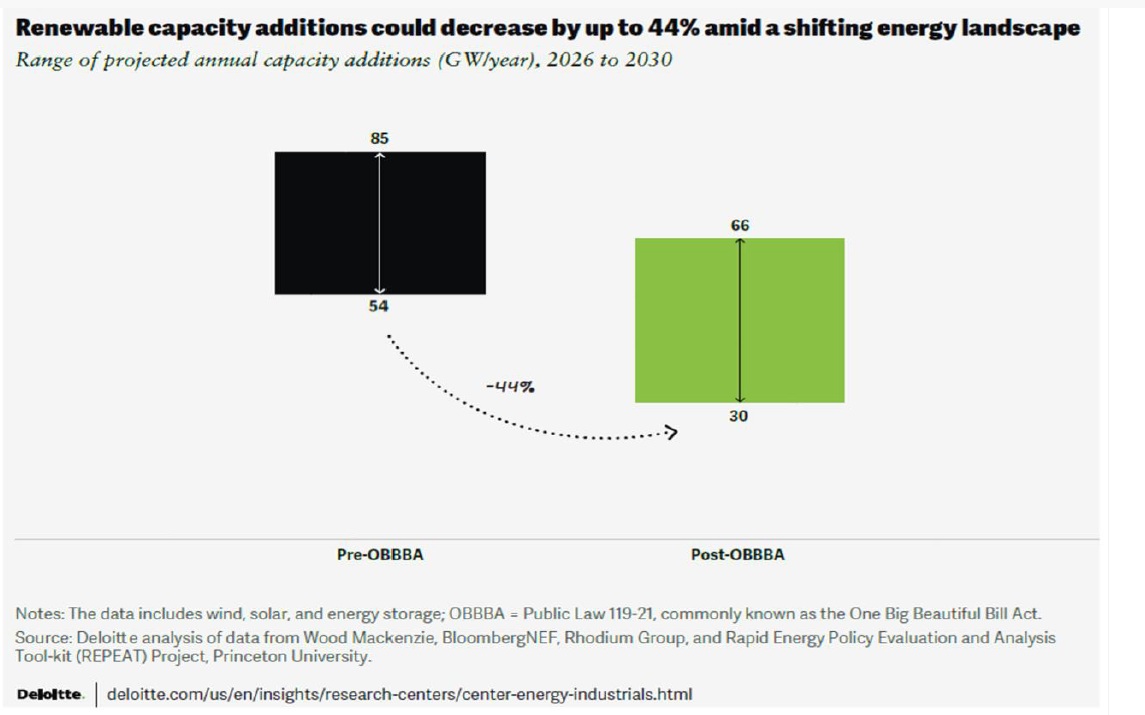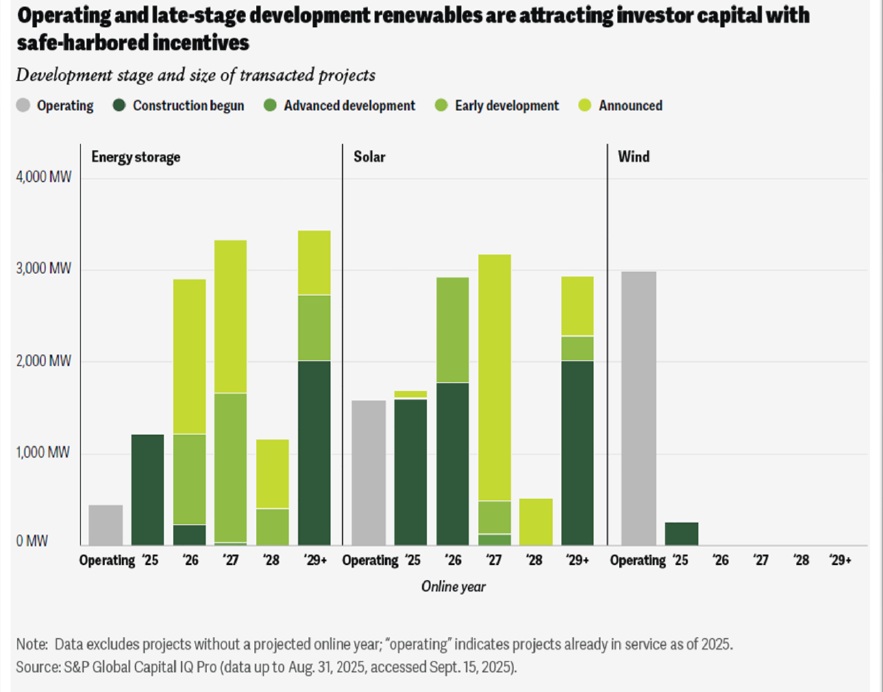| | | Five trends that will shape renewable energy in 2026
Renewables dominated capacity growth through September 2025 and by balancing speed with resilience, renewables can continue to contribute to a more resilient energy system that extends well beyond 2026, according to Deloitte’s Renewable Energy Industry Outlook.
October 30, 2025 Anne Fischer
Markets
Markets & Policy
United States

Image: Lincoln Electric Systems / Unsplash
Share
    
2025 has been a challenging year for renewables with passage of the One Big Beautiful Bill Act (OBBBA) that rolled back many clean energy tax credits and imposed new restrictions, pressuring early-stage wind and solar pipelines.
According to Deloitte’s 2026 Renewable Energy Industry Outlook, wind and solar investments in the first half of 2025 fell 18%, to nearly $35 billion (prior to the enactment of OBBBA), compared to the same period in 2024.
Deloitte outlines in its report five key trends that could help shape the year ahead:- Policy shifts: Adapting to a changing energy landscape
- Storage integration: Delivering clean, firm power on demand
- Capital and operational efficiency: Implementing leaner, smarter strategies
- Strategic M&A: Attracting capital through platform and mature assets
- Supply chain agility: Prioritizing alternative sourcing and reshoring
Policy shifts
Policy changes in the One Big Beautiful Bill Act (OBBBA) may worsen compressed timelines and raise costs, which the report states will reshape renewable economics. Not only did the bill shorten qualification windows for wind and solar credits, but new guidance from the Internal Revenue Service also requires continuous construction.
Foreign Entity of Concern (FEOC) restrictions increase supply chain pressures, making developers weigh credit value against compliance costs. Deloitte analysis projects that annual solar, wind and storage additions between 2026 and 2030 could fall to a range of 30 GW to 66 GW, down from a range of 54 GW to 85 GW under pre-OBBBA trajectories.

Image: Deloitte
While much focus has been on federal policy, state policy plays a significant role. According to Deloitte, in 2024, 28 states with renewable portfolio standards (RPS) drove 37% of renewable additions.
Yet the momentum across states is uneven and the report cites Ohio and North Carolina as examples. Ohio is sunsetting its RPS after 2026, while North Carolina rolled back its 2030 carbon reduction target, both citing affordability concerns. More states could revisit commitments under economic pressure, the report advises. Permitting and long-term targets remain critical levers, Deloitte says, but local opposition and interconnection queues still pose barriers.
Storage integration
The United States hosts 90% of hyperscalers’ global carbon-free energy contracts, with renewables supplying 78% and nuclear providing the rest, according to the report. Other options such as nuclear, hydro, enhanced geothermal and natural gas with carbon capture take years to develop, therefore clean energy with battery storage is the fastest solution, the report states.
By October 2025, operating storage capacity in the United States reached 37.4 GW, Deloitte estimates, up 32% year to date. Another 19 GW is under construction through 2026, with a 187 GW pipeline by 2030. The report notes that over half of the utility-scale storage coming online by 2026 is paired with solar, concentrated in three southwestern states.
Deloitte notes that technology innovation and distributed growth are significant factors driving the role of storage. On the technology side, lithium iron phosphate batteries are displacing nickel manganese cobalt lithium-ion batteries for cost and safety reasons, the report states, pointing to long-duration pilots that include 48-hour hydrogen-lithium hybrids and 100-hour iron-air batteries.
In addition, distributed storage has grown fivefold since 2020 to 4.8 GW in 2024, with Deloitte expecting another 4 GW by 2026. An example given in the report is virtual power plant (VPP) enrollment, which is aggregated distributed energy resources (DERs) like batteries, solar and electric vehicles acting as a single resource. The report estimates that VPPs reached 30 GW in 2024. Deloitte also notes that Federal Energy Regulatory Commission (FERC) Order 2222 is expected to accelerate aggregated DER participation in wholesale markets.
Capital and operational efficiency
Due to policy shifts and macroeconomic pressures, developers are much more cost conscious across equipment, design, engineering and labor aspects of projects while also accelerating project timelines, Deloitte finds.
At the same time, investors are expecting strategies that balance cost with growth and compressed credit timelines are driving more selective capital deployment, with emphasis on mature assets and financing structures that maximize returns, the report notes.
Developers and asset owners are pursuing three strategies: - Reprioritizing portfolios:Mature development and operating assets come first, especially those backed by long-term power purchase agreements (PPAs), followed by repowering and relicensing. Deloitte finds these priorities are funded by recycling capital through asset sales and divestitures, while large players and investors target operating assets and near-term pipelines for secure returns.
- Accelerating near-term projects:Developers are tapping into flexible financing to bridge construction costs and fast-track projects before credit expiration, the report indicates. Third-party ownership models are helping to sustain growth in residential solar.
- Capturing tax credit value:Developers are combining tax-equity partnerships with transferability benefits. Deloitte sees that phaseouts may simplify financing by reducing complexity and accelerating capital flows.
Deloitte finds that to enhance operational efficiency, developers are standardizing design, optimizing procurement and streamlining operations and maintenance, often using AI-driven tools to support these goals.
With 76% of U.S. power and renewable executives planning to increase AI spending in 2025, the study finds companies are recognizing that efficiency gains require talent, governance, collaboration and technology.
Strategic M&A
Well-capitalized investors and operators are seeking stable returns and pursuing differentiated strategies, according to Deloitte. For example, strategic energy firms, private equity firms, and infrastructure funds are prioritizing established platforms; developers that combine operating projects with late-stage pipelines, teams, and scale, and de-risked portfolios. On the other hand, developers and independent power producers recycle capital by selling mature, PPA-backed assets to fund near-term pipelines, the report states.
In the first nine months of 2025, the report estimates that $6 billion across 58 renewable deals were announced; a 41% fall in value and a 45% drop in volume from the prior year. Platform acquisitions surged 4.6x in value, however, as financial buyers pivoted to company-level purchases to secure scale and talent. Deloitte points to multi-billion-dollar transactions as examples, such as TPG’s $2.2 billion acquisition of Altus Power and the $1.7 billion sale of National Grid Renewables to Brookfield Asset Management.
Asset-level deals slowed sharply, down 89% in volume in the first eight months of 2025 compared with 2024, Deloitte states. Of the 58.4 GW pipeline capacity transacted, the report estimates that 38% is positioned to meet the safe-harbor deadlines, with 15% already under construction. The report notes that investor focus on hybrid capacity and PPA-backed stability is evidenced by the sale of solar-plus-storage portfolios such as Repsol’s 777 MW portfolio across New Mexico and Texas and Samsung C&T’s 111 MW portfolio in Colorado.

Image: Deloitte
Supply chain agility
Prioritizing alternative sourcing and reshoring is necessary for supply chain agility, according to Deloitte, as FEOC restrictions, changes to the 45X advanced manufacturing production tax credit, and expanding tariffs raise costs. In addition, trade enforcement actions are intensifying exposure, the report notes. Antidumping and countervailing duties impose tariffs of up to 3,404% on solar imports from four Southeast Asian countries, while Section 232 tariffs add costs to metals.
Deloitte estimates that solar production has expanded sevenfold to 56.5 GW since 2022, outpacing the 2024 demand of 35.3 GW. Yet, cells, wafers, ingots, and polysilicon must still be imported. On the storage side, China supplied 70% of the lithium-ion batteries to the United States in 2024, the report states, with over 83% of the planned 219 GW of grid storage could lose credits under FEOC rules starting in 2026.
“Companies adapting fast can gain an edge,” the report states. An example is firms that are securing non-FEOC inputs for key components. Deloitte estimates that from 2023 to the start of the antidumping and countervailing duties probe by the International Trade Commission in May 2024, developers stockpiled 35 GW of solar modules. At the same time, digital tools and flexible contracting improve visibility, Deloitte said, while executives stress-test strategies via scenario planning.
In the longer term, reshoring and scaling will be important, according to the report. An example given is a leading solar manufacturer that is targeting 14 GW of U.S. module capacity by 2026.
Overall, the report concludes that compressed timelines and intensifying competition will define 2026, with the imperative being to accelerate near-term deployment to capture credits while positioning for continuity through 2030 under safe-harbor and construction-start provisions. Deloitte expects renewable developers to emphasize near-term agility, which includes diversifying inputs, stockpiling, and digitizing visibility, while investing in long-term resilience through reshoring, recycling and partnerships.
pv-magazine-usa.com |
|







